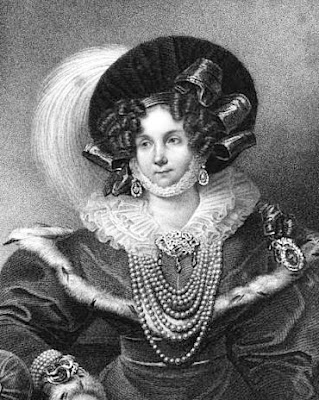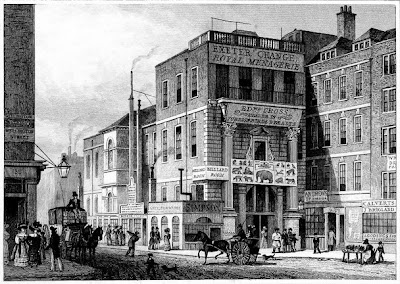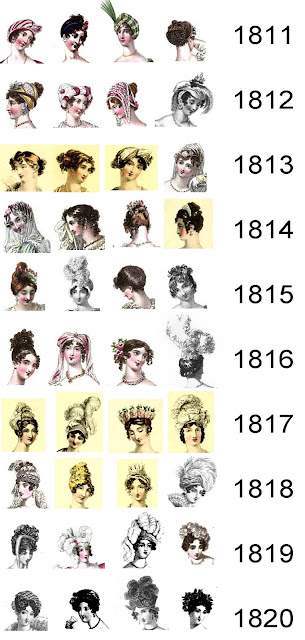 |
| HRH Ernest, Duke of Cumberland from A Biographical Memoir of Frederick, Duke of York and Albany by J Watkins (1827) |
Early years
Prince Ernest Augustus was born at Buckingham House on 5 June 1771. Ernest grew up at Kew, housed with his younger brothers, Augustus and Adolphus. The three Princes were made Knights of the Garter on 2 June 1786 and shortly after, were sent to the University of Göttingen to study.
Although commended for fighting bravely, he had a reputation for treating his men harshly and, despite regular promotion and being gazetted Field Marshal in 1813, he never saw active service abroad again.
Duke of Cumberland
On 23 April 1799, Ernest was made Duke of Cumberland and Teviotdale and Earl of Armagh and awarded a grant of £12000 a year by parliament.
Extreme politics
 |
| George IV from Memoirs of her late royal highness Charlotte Augusta by Robert Huish (1818) |
In character, he was radical and outspoken. He was able to wield a great deal of influence over weaker minds, notably over his brother George IV, whom he pushed towards his own radical Tory policies.
Ernest is not a bad fellow, but if anyone has a corn, he will be sure to tread on it.1
 |
| Frederica, Duchess of Cumberland from La Belle Assemblée (1830) |
The Queen disapproved of Princess Frederica who had been unofficially engaged to marry the Duke of Cambridge in 1797 but had become pregnant by the Prince of Solms-Braunfels and married him instead. Ernest’s marriage was very unpopular and parliament refused to increase his allowance, forcing the couple to live abroad, largely in Berlin, where their son George was born on 27 May 1819.
King of Hanover
When William IV died on 20 June 1837, his niece Victoria became Queen of England. But she could not accede to the throne in Hanover which could only pass to the male line, and so Ernest became King of Hanover. He entered his capital on 28 June and proceeded to attack the liberal constitution. He ruled autocratically, but listened to reasonable complaints and avoided any hint of revolution. Ernest was a good king and well-respected in Hanover and he successfully ruled during a very unsettled period in Europe.
A life of scandal
The Duke of Cumberland’s life was beset with scandal. On 31 May 1810, his valet was found dead and rumours circulated that he had murdered him, though the jury passed a verdict of suicide.
You can read more about the scandalous death of his valet here.
In 1813, he was involved in a political controversy over a parliamentary election in Weymouth. He was accused of influencing the outcome in favour of the Tories, which was considered improper behaviour for a member of the House of Lords.
Years later, he wrangled with Queen Victoria over some jewels that he declared were his by right under Queen Charlotte’s will and which his niece refused to give up. The bitter dialogue between the parties caused considerable embarrassment to the government and when Ernest visited England for three months in 1843, Queen Victoria showed her continued disapproval by only inviting him once to dinner.
Yet more scandal
In 1829, Ernest created a scandal over Lady Lyndhurst who claimed that he had tried to assault her and, when she resisted, had threatened to ruin her and her husband. The following year, he faced another over Lady Graves. Rumours of a relationship between Ernest and Lady Graves reached the ears of her estranged husband. Lord Graves wrote a note declaring that he did not believe them, but nevertheless committed suicide.
But the most serious scandal which confronted Ernest was in relation to his sister, Princess Sophia. His affection for her was judged by some to be unhealthily intense, and it gave rise to the rumour that he had fathered the illegitimate son she was said to have given birth to in 1800. Although this was almost definitely untrue, there are comments in her letters which hint at the possibility that he had tried to assault her.
 |
| Princess Sophia from A Biographical Memoir of Frederick, Duke of York and Albany by John Watkins (1827) |
If you have enjoyed this blog and want to encourage me and help me to keep making my research freely available, please buy me a virtual cup of coffee by clicking the button below.
Note
1. From The Letters of Queen Victoria (1908)
Sources used include:
Fulford, Roger, Royal Dukes (1933, revised 1973)
Hibbert, Christopher, George III (1998, Viking, Great Britain)
Hibbert, Christopher, George IV (1972, Longmans, 1973, Allen Lane, London)
Hibbert, Christopher, Queen Victoria (HarperCollins, 2000, London)
Huish, Robert, Memoirs of her late royal highness Charlotte Augusta (1818)
Palmer, Alan, Ernest Augustus (1771-1851), Oxford Dictionary of National Biography, (Oxford University Press, 2004, online edn, May 2009, accessed 23 Mar 2013)
Victoria, Queen, The Letters of Queen Victoria, A Selection from Her Majesty's Correspondence between the years 1837 and 1861, edited Benson, AC and Esher, Viscount, Vol I 1837-1843 (1908)
Watkins, John, A Biographical Memoir of Frederick, Duke of York and Albany (1827, London)








































